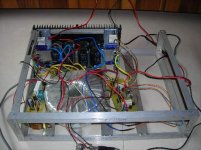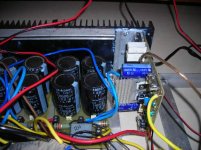Nice work Max67, glad you like the amp. Make sure you build some sort of DC detection circuit before you finish your build.
Congratulations on a good result.
Cheers
Q
Congratulations on a good result.
Cheers
Q
Hi Max.
It is really good to hear that but as Quasi said you must put DC protection in it.
Can you tell me what type of transformer and power supply are you using with Nmos200?
Regards
It is really good to hear that but as Quasi said you must put DC protection in it.
Can you tell me what type of transformer and power supply are you using with Nmos200?
Regards
I have used 300 VA transformer 32-0-32 v ac and so about +45/-45 VDC .
The power supply is only for the test, no final version.
Now i must built dc protection.
Regards
The power supply is only for the test, no final version.
Now i must built dc protection.
Regards
Hi Quasi ;
Can I use the computer processor heat sinks with Nmos200 or do I need bigger heat sinks?
reg
Can I use the computer processor heat sinks with Nmos200 or do I need bigger heat sinks?
reg
To Wasim:
Use 2 socket A or P4 sinks for each channel. Screw each pair
(or 4 for stereo) together using the L bracket...like this:
Will dissapate enough without active cooling for 8R0 load
4R0 might require fan.
P.S. unit above cools 8 devices ,fans only engage with
heavy use.
Use 2 socket A or P4 sinks for each channel. Screw each pair
(or 4 for stereo) together using the L bracket...like this:
An externally hosted image should be here but it was not working when we last tested it.
Will dissapate enough without active cooling for 8R0 load
4R0 might require fan.
P.S. unit above cools 8 devices ,fans only engage with
heavy use.
Hi
Got everything ready, the heatsink drilled, the board... except the protection zener discussed on page 122. Would a 12V 1w + a 1n4002/4/7 do the job?
Tks
Got everything ready, the heatsink drilled, the board... except the protection zener discussed on page 122. Would a 12V 1w + a 1n4002/4/7 do the job?
Tks
Finally, got both my two pair NMOS going today😀 😀 Tested them for a long time at quite levels, man the NMOS really rocks
Will post some pics soon.
Thank you Quasi.
Hari

Will post some pics soon.
Thank you Quasi.
Hari
I want build Nmos too,...
but is it possibile in Quasis Design to change
1. BC546/BC556 and 2SC1845
with MPSA42 / MPSA92 or 2 SA970/2SC2240 because I have a lot of from this devices and easy to get by my local dealer
2. T9 and T10 I want replace with 2SA1943/2SC5200 because i want drive 10 pcs. IRFP460 Mosfets
WHY ? I have found this Information in
http://sound.westhost.com/articles/hexfet.htm
1. Fix: Drive the gates with as much current as possible. This may include adding a class AB driver stage.
Why: HEXFETs have a nonlinear transfer curve up to about an amp or two, depending on the device(s) used. In a class AB amplifier, this characteristic is the cause for a majority of the THD. When driven with enough current, the device will follow the 'new' linear curve, since it is balancing out the nonlinear gate capacitance. The lower impedance of the driver stage the better.
2. I get this message from IRF:
IR HEXFET® MOSFETs are designed to be used as Switches. This does not preclude their use in linear applications but as the device technology advances to provide ever better performance as switches with lower Rds(0n) and gate charge figures, this makes the devices ever less suitable for linear applications. A lower Rds(on) equates to an output characteristic with a steep slope, which makes it difficult to maintain a suitable gate bias to keep the drain current operating point stable. As the drain current is deliberately varied in response to an applied input voltage, this changes the dissipated power within the part, changing the junction temperature and thus the value of Rds(on), i.e the slope of the output characteristic. If the device is being used in audio amplifier applications, other than class D for which most are ideally suited, the frequency of Rdson variation will not be seen as a fast variation as the thermal inertia will average them out to produce an average value for Rdson. This is the value you would use to solve the thermal equlibrium equation to determine if the Tj achieved in the application will be within permitted limits or not.
As higher voltage MOSFETS have higher Rds(on) values and thus a more shallow output slope these will be more suitable for linear applications.
All our current Application Notes are written around switching operations and we have none dealing directly with linear amplifier circuits.
3. Only IXYS www.ixys.com offer LINEAR Power Mosfets to solve this problem, buts its very hard to get it.
but is it possibile in Quasis Design to change
1. BC546/BC556 and 2SC1845
with MPSA42 / MPSA92 or 2 SA970/2SC2240 because I have a lot of from this devices and easy to get by my local dealer
2. T9 and T10 I want replace with 2SA1943/2SC5200 because i want drive 10 pcs. IRFP460 Mosfets
WHY ? I have found this Information in
http://sound.westhost.com/articles/hexfet.htm
1. Fix: Drive the gates with as much current as possible. This may include adding a class AB driver stage.
Why: HEXFETs have a nonlinear transfer curve up to about an amp or two, depending on the device(s) used. In a class AB amplifier, this characteristic is the cause for a majority of the THD. When driven with enough current, the device will follow the 'new' linear curve, since it is balancing out the nonlinear gate capacitance. The lower impedance of the driver stage the better.
2. I get this message from IRF:
IR HEXFET® MOSFETs are designed to be used as Switches. This does not preclude their use in linear applications but as the device technology advances to provide ever better performance as switches with lower Rds(0n) and gate charge figures, this makes the devices ever less suitable for linear applications. A lower Rds(on) equates to an output characteristic with a steep slope, which makes it difficult to maintain a suitable gate bias to keep the drain current operating point stable. As the drain current is deliberately varied in response to an applied input voltage, this changes the dissipated power within the part, changing the junction temperature and thus the value of Rds(on), i.e the slope of the output characteristic. If the device is being used in audio amplifier applications, other than class D for which most are ideally suited, the frequency of Rdson variation will not be seen as a fast variation as the thermal inertia will average them out to produce an average value for Rdson. This is the value you would use to solve the thermal equlibrium equation to determine if the Tj achieved in the application will be within permitted limits or not.
As higher voltage MOSFETS have higher Rds(on) values and thus a more shallow output slope these will be more suitable for linear applications.
All our current Application Notes are written around switching operations and we have none dealing directly with linear amplifier circuits.
3. Only IXYS www.ixys.com offer LINEAR Power Mosfets to solve this problem, buts its very hard to get it.
ravslanka said:hi jethari
where did you get your toroid from and how much did it cost you
I got the toroid from a local manufacturer here in Mumbai - Toroid Engineers. I dont immediately recall the price but it was quite reasonable. He also makes the toroids and mails them by courier if you want.
Hari
Wasim said:Hi All,
Is it fine using 32 0 32 ---- 5AMP Transformer with Nmos200?
Regards
Wasim
32-0-32 AC will give you about 42-0-42 DC. You might fall just a little short on the output power.
Hari
By QSA : T9 and T10 I want replace with 2SA1943/2SC5200 because i want drive 10 pcs. IRFP460 Mosfets
Maybe going too far?? I use a amp similar to "brother of Quasi"
in a BJT OP stage and use the 8 amp mje15032/33 drivers(to-220)
which are so strong they can run a speaker by themselves.
(10w amp without OP stage).
I think they would have no problem driving 8-10 gates on
the IRF's and have much better Hfe than the toshiba's
(5200/1943). If you added the toshiba's after the mje340/350
drivers you would have a triple OP stage which would force you to
modify the Vbias circuit. I think if you drove the toshiba's
directly off the VAS stage you'll experience non-linearity in
the amp.(load the VAS)
The other transistor choices for the LPT will work as long as
Vce is high enough.(100-120v for a large amp)
OS
Bigpanda :
Got everything ready, the heatsink drilled, the board... except the protection zener discussed on page 122. Would a 12V 1w + a 1n4002/4/7 do the job?
So anyone kind enough to give some comment on this?
Tks
- Home
- Amplifiers
- Solid State
- Power amp under development


